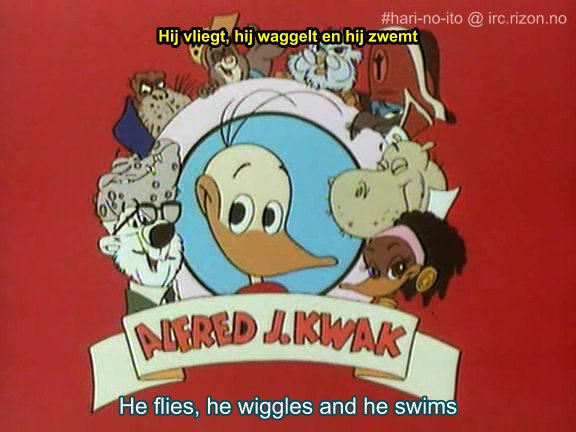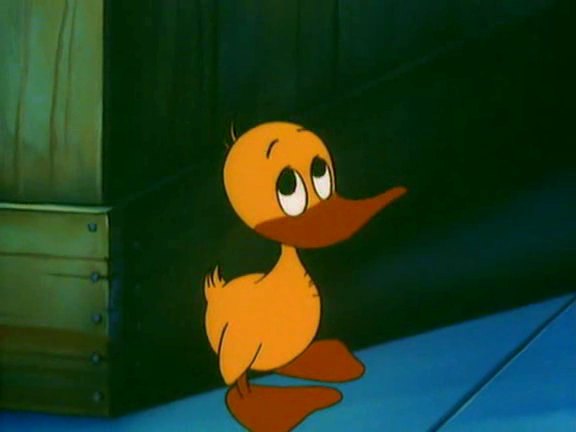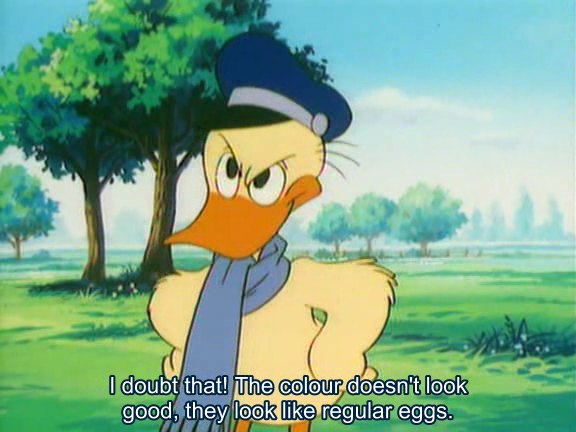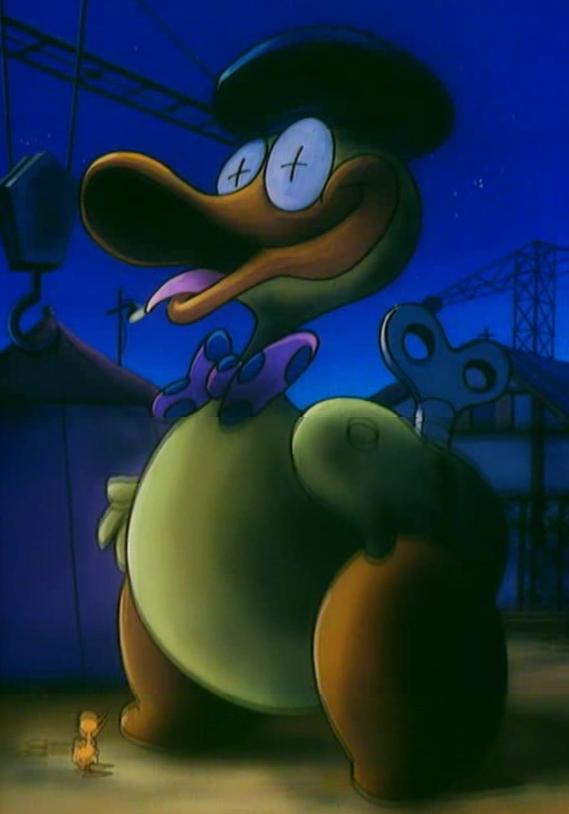November 04, 2007
This has occurred today. Today, a fansub group released episode 1 of The Greatest Anime Ever. Ladies and Gentlemen, for your entertainment, may I present...

...flying, check, good for a duck. Swimming, check, good for a duck. Wiggles?
ALFRED J. KWAK, or Ahiru no Quack in Japan. This is an important distinction, because AJK was originally a Dutch-Japanese collaboration that was translated into no less than seventeen different languages! While a children's show, it appears to be headed into quite mature territory.
According to Wikipedia, for example, In episode 1, Alfred is hatched, and minutes later, evil land developers turn his home near a stream into a theme park. Alfred's family is killed in a car accident in episode 2. His opponent is named "Dolf", and is apparently based on Adolf Hitler (though we haven't met him yet). The characters age over the course of the 52 episode run.

Our hero as a young man duck.
As you can tell from looking at the screenshots, this is an old show, starting in 1989. It's not bad, for a children's show, all things considered. The transfer to the OGM format is pretty poor, with any movement being blurry; that's probably an artifact of the original DVD source material. Still shots look fine, if a little soft-focus.

Our hero's father, taking umbrage at the slight on his family...
Truthfully, I'm sure I wouldn't've watched this if it didn't have a duck as the main character (and I didn't have broadband). However, I'm glad I did... it's fun, and there's a lot of potential here. ANN says it's a historical show, teaching children about life and such things as WWII. If so, I can't wait.
One huge surprise, though, was the voice of Alfred. The moment I heard the theme song, I thought "I know who that is," and a look at the cast list confirmed it: Megumi Hayashibara, performing in only her fifth or sixth show, and what might be her first lead (I can't tell if Ranma 1/2 debuted before or after). It's a piece of anime history, and it's about ducks! How cool is that???
And in this episode, Steven's worst nightmare comes true:

Soon... oh, so soon...
The first recorded instance of a Bionic Duck! Bwah-ha-ha-ha-haaaaaaaah!!!
Actually, this shot is a good example of the problems with the transfer. This is a composite of three different screenshots: the head, the torso, and the legs. The head shot was snapped when there was no movement on-screen. The other two were taken during a slow pan down... and you can see the result, particularly when you take a look at Alfred down there in the corner.
Posted by: Wonderduck at
01:44 AM
| Comments (6)
| Add Comment
Post contains 477 words, total size 5 kb.
Posted by: Steven Den Beste at November 04, 2007 06:41 AM (+rSRq)
Posted by: Avatar_exADV at November 04, 2007 10:41 PM (LMDdY)
For all I know, Avatar, it's something more base than that... maybe it's left over from the original source material, and is actually on the DVDs. Perhaps the masters were of low quality... no way to tell without talking to the fansub group.
Posted by: Wonderduck at November 05, 2007 12:21 AM (DcSb+)
What I think you're seeing is a function of trying to convert 24 fps film to 30 fps video. There are a number of approaches to that, but one that some people seem to like is to mix neighboring frames together.
When I did my review of Miyuki-chan in Wonderland I had a devil of a time finding clean frames I could grab as examples. The majority of the frames were mixtures of adjacent frames from the original 24 fps film, which is what they used to create up to the mid 1990's.
When the switch to digital began, they began from the back end. The first thing to be replaced was the light table and frame camera, and it meant they started mastering to 30 fps.
Older stuff doesn't always use that. Another digitization approach is field dithering. (Probably not the official term for it.) 30 frame per second interlaced video is 60 fields per second. Some frames from the 24 frame-per-second film are given two fields in the video and some are given three, in order to make the timing come out right. If the player is creating interlaced video, it doesn't have to do anything about that, but if it's producing non-interlaced video then it has to merge those together at display time when the two fields of any given video frame don't match.
But I bet that this show is using master-side frame merging, like Miyuki-chan did, rather than field dithering.
Posted by: Steven Den Beste at November 05, 2007 12:47 AM (+rSRq)
Posted by: Wonderduck at November 05, 2007 01:14 AM (DcSb+)
Posted by: Pixy Misa at November 05, 2007 01:18 AM (PiXy!)
47 queries taking 0.2366 seconds, 282 records returned.
Powered by Minx 1.1.6c-pink.









